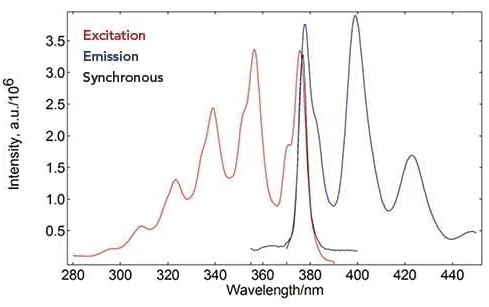A Short Introduction to Fluorescence Measurements & Instrumentation
Fluorescence (or more broadly, photoluminescence) is a sensitive, non-destructive technique that is simple to use but requires advanced instrumentation. Acquiring good fluorescence measurements needs a basic understanding of how a fluorescence spectrometer works, as well as following good measurement practice in the lab. Here we provide an introduction to steady-state fluorescence spectrometers (the most common type) and the basic types of fluorescence measurements that can be performed with them.
Introduction to Fluorescence Instrumentation
The basic components of fluorescence spectrometers are a white light source, excitation monochromator, sample chamber, emission monochromator, and detector. Advanced instruments can be configured with multiple sources, detectors and sample holders.
The figure above shows the layout of an FLS1000 photoluminescence spectrometer. Steady state fluorescence measurements require a continuous excitation source. This is usually a continuous xenon lamp which generates intense white light, from 230 nm up to the near-infrared range. The excitation monochromator selects the desired wavelength of excitation light, which is focused at the sample position. The monochromator selects the desired wavelength of excitation light, which is focused at the sample position. The monochomator utilises diffraction gratings and slits to select light if a particular wavelength and reject the rest of the excitation lamp spectrum: as the gratings rotate, the centre wavelength varies. The slits control the bandpass, or the width of the wavelength interval that passes through the monochromator such as the one in the figure. Double monochromators provide better stray light rejection and therefore a higher signal-to-noise ratio for the instrument.
The emission light, which is of longer wavelength than the excitation, is filtered by the emission monochromator. This selects the wavelength of the light that reaches the detector which is typically a photon-counting photomultiplier tube (PMT). PMT detectors are capable of detecting single photons so it is important that any unwanted light is effectively rejected by the monochromator, to avoid any background on the emission spectrum. The excitation and emission paths are set at an angle of 90∘ to each other to minimise the fraction of excitation light entering the emission arm.
Excitation and Emission Spectra
Two types of fluorescence spectra may be measured: excitation and emission. An excitation spectrum is obtained by scanning the excitation wavelength and keeping the emission wavelength constant, and recording the photons reaching the detector. An emission spectrum is recorded in the same fashion, but scanning the emission wavelength at a constant excitation wavelength. It is also possible to acquire synchronous spectra by simultaneously scanning the excitation and emission wavelengths. The spectra provide information on the absorption and emission properties of the sample, and are typically plotted as a function of counts (number of detected photons) against wavelength.
 The figure above shows excitation, emission and synchronous fluorescence spectra of a solution of anthracence in cyclohexane. The X axis shows the wavelength scanned (excitation for the red curve and emission for the blue and black curves). The excitation spectrum was acquired with the emission wavelength set at 400 nm, whereas the emission spectrum was recorded at 356 nm excitation. The Y axis shows the number of detected photons after correcting for spectral differences in excitation intensity and detection sensitivity. This type of photometric correction is automatically applied by good-quality commercial spectrometers.
The figure above shows excitation, emission and synchronous fluorescence spectra of a solution of anthracence in cyclohexane. The X axis shows the wavelength scanned (excitation for the red curve and emission for the blue and black curves). The excitation spectrum was acquired with the emission wavelength set at 400 nm, whereas the emission spectrum was recorded at 356 nm excitation. The Y axis shows the number of detected photons after correcting for spectral differences in excitation intensity and detection sensitivity. This type of photometric correction is automatically applied by good-quality commercial spectrometers.
Basic steady state fluorescence spectrometers are available from Edinburgh Instruments, as well as advanced instruments for demanding fluorescence applications. For further information, please contact us or join our mailing list.
Fluorescence Spectrometer Range
Why not take a moment to browse our fluorescence spectrometer range. Our Scientists and Sales Teams would be happy to discuss any requirements you may have to suit your research. For further information on our fluorescence spectrometers, please contact us.
Follow Edinburgh Instruments
To find out how our fluorescence instrumentation can help you with your fluorescence measurements and research, please contact us at sales@edinst.com, or sign-up to our infrequent newsletter via the red sign-up button below.









